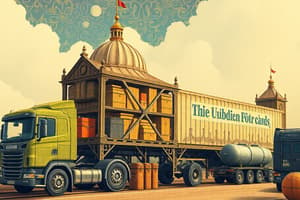Podcast
Questions and Answers
What is supply chain management?
What is supply chain management?
Supply chain management unifies a network of connected but interdependent organizations, mutually and cooperatively working together to control, manage and improve the flow of material and information from the suppliers to the end users.
Which of the following statements accurately describe logistics?
Which of the following statements accurately describe logistics?
- It is a part of supply chain management. (correct)
- It does not involve the management of information.
- It aims to achieve customer service at the highest possible cost.
- It focuses solely on the flow of goods.
The Just-In-Time (JIT) inventory system aligns raw-material orders from suppliers directly with production schedules.
The Just-In-Time (JIT) inventory system aligns raw-material orders from suppliers directly with production schedules.
True (A)
What are the main goals of logistics management?
What are the main goals of logistics management?
What is Total Quality Management (TQM)?
What is Total Quality Management (TQM)?
Logistics is responsible for moving materials through their _________.
Logistics is responsible for moving materials through their _________.
What is the focus of supply chain management in the 2000s and beyond?
What is the focus of supply chain management in the 2000s and beyond?
Study Notes
Supply Chain & Logistics Management Definition
- Supply chain management (SCM) unifies and manages a network of interconnected organisations working together to control, manage, and improve the flow of materials and information from suppliers to end users while increasing value for the end user at a lower cost.
The Evolutions of Supply Chain Management
- 1950s-1960s: U.S. manufacturers focused on mass production techniques to reduce costs and improve productivity.
- 1960s-1970s: New computer technologies led to the development of Materials Requirements Planning (MRP) and Manufacturing Resource Planning (MRPII) to coordinate inventory management and improve internal communications.
- 1980s-1990s: Intense global competition forced U.S. manufacturers to adopt:
- Just-In-Time (JIT) to align raw-material orders with production schedules.
- Total Quality Management (TQM) as a continuous process of detecting and reducing errors in manufacturing, improving supply chains, customer experiences, and employee training.
- Business Process Reengineering (BPR) to fundamentally rethink how work is done to improve customer service, cut costs, and become global competitors.
- Customer Relationship Management (CRM) to manage and analyze interactions with past, current, and potential customers.
- 2000s and Beyond: Focused on improving supply chain capabilities with initiatives such as:
- Third-party service providers (3PLs).
- Integrating logistics as a business management process that governs the flow of materials, information, and goods from origin to arrival, with interconnected and interdependent management activities.
- Client/server SCM software - Enterprise Resource Planning.
- Today: Focus on the environmental and social impacts of supply chains with:
- Sustainability, emphasizing meeting current supply chain needs without hindering future generations.
- The Triple Bottom Line: Taking care of people, the planet, and profits.
Logistics Management: Definition
- Logistics management plans, implements, and controls the efficient and effective forward and reverse flow of goods, services, and related information from origin to consumption to meet customer requirements.
- Logistics involves managing the flow of items, information, cash, and ideas through coordinating supply chain processes and strategically adding place, period, and pattern values.
- Logistics is the function responsible for moving materials through its supply chain.
The Goal of Logistics:
- Achieve target levels of customer service at the lowest possible cost.
- Logistics addresses a wide set of activities dedicated to transforming: ...
Studying That Suits You
Use AI to generate personalized quizzes and flashcards to suit your learning preferences.
Related Documents
Description
Explore the evolution and definition of supply chain management. This quiz covers key concepts from the 1950s to the 1990s and their impact on modern practices. Test your knowledge on how these changes have shaped supply chain strategies today.




